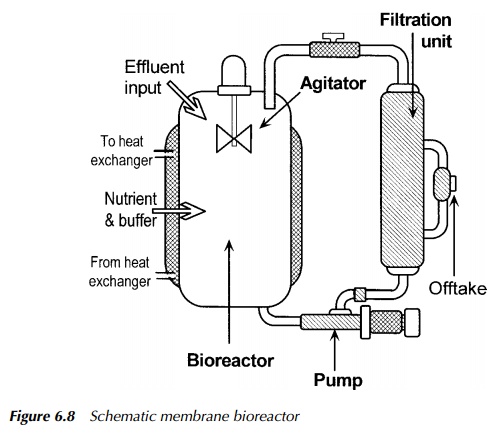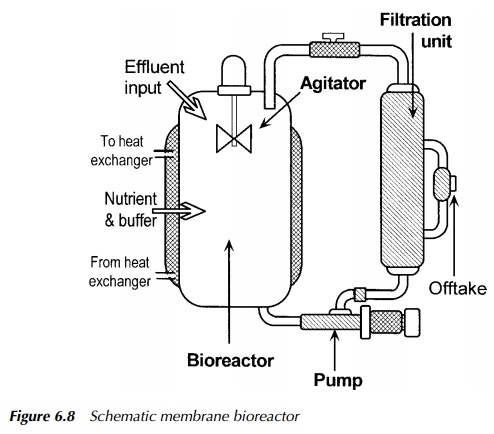Chapter: Environmental Biotechnology: Aerobes and Effluents
Membrane Bioreactors

Membrane Bioreactors
This system, instead of utilising conventional methods of gravity
settlement, achieves the desired biomass retention by means of a cross-flow
filtration process, as shown in Figure 6.8.
The development of effective
methods of micro- and ultra-filtration has opened up the potential for using
membrane bioreactor technology on various forms of domestic and industrial
effluents. There are three general types of reactor systems which have been
developed, namely solid/liquid separation, gas permeable and extractive
systems. The membrane element allows the passage of small molecules, but
retains the total resident microbial population. As a result, the cumulative
overall bioactivity and the resultant speed of remediation is boosted, since
not only are micro-organisms no longer lost with wash-out flow, but also,
conditions for even the slowest-growing member species of the microbial
community are able to be adequately enhanced. This is of particular relevance
to xenobiotics and the more recalcitrant components of wastewaters, as their
biological break-down is often brought about by bacteria which themselves have
a relatively long establishment period within the population. The high biomass
levels within the bioreactor itself obviously necessitate abundant readily
available oxygen, though the high organic loading and efficient intrasystem
microbial conservation com-bine to make the hydraulic retention time entirely
independent of the solids
Since the membrane allows gaseous transport while
constraining the biological phase, there is provision within the reactor for
bubbleless aeration and oxygenation consequently can take place over a
relatively large surface area, thereby improving the efficiency of this
process. In addition, the membrane itself may become an attachment zone for
biofilm formation.
Thus, the membrane
bioreactor can offer a greater degradation capacity for per-sistent chemicals,
making possible the biological removal of benzene, nitroben-zene,
dichloroaniline and polyaromatic hydrocarbons (PAHs), for example, which
represent a significant risk, both to the environment and human health, due to
their high toxicity. Removal efficiency for these substances can approach 99%.

The membrane bioreactor has
proved its suitability as an efficient system for degradation of recalcitrant
compounds and significantly higher biomass con-centrations and utilisation
rates are routinely achieved than in corresponding alternative treatment systems.
In common with most operational, rather than experimental, biological
detoxification processes, not all of the contaminants present in the effluent
are typically completely converted into carbon dioxide and water, a certain
percentage being turned into metabolic byproducts instead, though this can
amount to less than 5% in a well-managed bioreactor system. Part of this
involves the gradual and controlled introduction of novel wastewater elements,
to ensure that acclimatisation is maximised and any potential tendency for
‘shock loadings’ avoided. This is a clear example of the value of permitting
optimised microbial adaptation to the individual application.
These systems are, of
course, more expensive than the conventional activated sludge or trickling
filters, but produce a much smaller quantity of excess sludge for subsequent
disposal of treatment. In addition, they produce an elevated COD removal and
would seem particularly well suited to use in small-scale plants where the
production of high-quality final effluent is a priority.
Related Topics